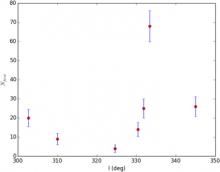
Abstract
We present results from spectroscopic observations of a trio of Cepheid candidates identified from Ks -band light curves toward Norma. The spectra show that these stars are moving with a large and similar radial velocity—the heliocentric velocities are 171 ± 32 km s−1, 164 ± 37 km s−1, and 173 ± 20 km s−1. The average radial velocity is ~169 km s−1, which is large and distinct from typical stars in the Galaxy's stellar disk. Given the radial velocities and associated 1σ error, we find that the combined probability that these three stars are foreground Milky Way disk stars is ~7 × 10−4%, and the probability that these are large-amplitude spotted stars in a binary is ~10−5%. These objects at l ~ 333° and b ~ −1° are therefore associated with the stellar halo. The identification of these sources as Type I Cepheids is not certain, and thus the distances of these sources are not yet well established. Assuming the 3.6 μm period–luminosity relation of Type I Cepheids gives a distance of ~78 kpc for these sources.